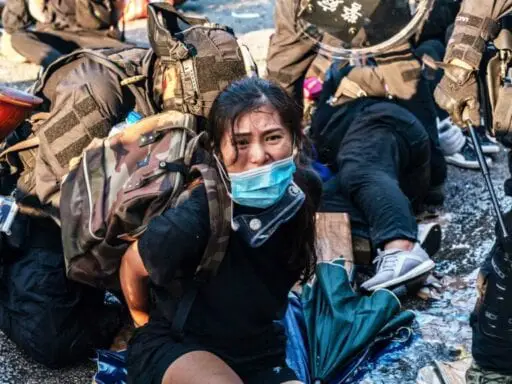Police fired on a teenage protester, injuring him in the chest.
Pro-democracy protesters and police clashed as demonstrations engulfed Hong Kong in defiance of China’s 70th anniversary celebration of the founding of its Communist regime.
The 18th consecutive week of protest in Hong Kong erupted in an even more charged atmosphere as Beijing marked the 70th anniversary of the founding of the People’s Republic of China, known as “National Day.” The October 1 commemoration had been seen as a possible turning point in the pro-democracy movement as some feared China would move to aggressively squash the demonstrations ahead of the celebration.
That led to widespread unrest across Hong Kong as protesters organized demonstrations — deemed a “national day of grief” — in a direct challenge to Beijing. The result was some of the worst violence the autonomous territory has seen since the movement began months ago and it brought parts of Hong Kong close to a standstill.
Protests began peacefully Tuesday with tens of thousands marching in one of Hong Kong’s main business districts. But as the day ground on and the protesters splintered off, the mood turned tense.
According to BuzzFeed, Hong Kong officials, anticipating the protests, shut down transit stations and posted police outside of potential meeting spots to deter demonstrators from meeting up.
More tear gas in wan chai pic.twitter.com/ReCcW3QnMV
— Rosalind Adams (@RosalindZAdams) October 1, 2019
But it did little to stop the protests. Demonstrators built barricades and flung firebombs, bricks, and other objects back at law enforcement. Protesters also set fires and trashed and vandalized transit stations and government buildings. Police in riot gear fired tear gas and water cannons back at the crowds.
This #HongKong government office in the residential district of Sham Shui Po was pretty much trashed by protesters – and burned. Metro entrances were are assaulted with a fire started in front of at least one gate. @CBSNews is here. #HongKongProtests pic.twitter.com/rb3SjCNTHc
— Ramy Inocencio 英若明 (@RamyInocencio) October 1, 2019
Hong Kong has witnessed such skirmishes before in the months-long uprising, but the situation escalated dramatically on Tuesday after a police officer fired a shot and wounded a teenage boy at the protests. The teen, believed to be a high school student, is in critical condition, according to the Hong Kong Free Press; he’s the first protester injured by live ammunition since demonstrations began in June.
The police defended their actions, saying the officer acted in self-defense. A graphic video (below) purports to show the incident.
A police officer was filmed on Tuesday firing what appeared to be a live round at a protester during clashes in Tsuen Wan. Source: HKU SU’s Campus TV.
Full story: https://t.co/OC5OEQyFdY #HongKong #China #antiELABhk #antiELAB pic.twitter.com/8CaBdM2xjg
— Hong Kong Free Press (@HongKongFP) October 1, 2019
At least 50 others have been injured and more than 100 people have been arrested in Tuesday’s protests. But the shooting of the teen is likely to galvanize activists, who’ve been calling for an independent investigation of police tactics and use of force as part of their list of demands.
The Hong Kong protests intensified in June over a controversial extradition bill that would have allowed for people accused of crimes to be sent to face trial in mainland China, which many critics feared would allow Beijing to target dissidents and others critical of the Communist Party.
Hong Kong’s chief executive Carrie Lam formally withdrew the extradition law in early September after weeks of relentless protests. But by then, many pro-democracy protesters interpreted the concession as insufficient, as it came far too late and failed to address all of their grievances.
In addition to calling for an independent investigation into police tactics, protesters want all activists arrested to be freed with charges dropped. They are also demanding universal suffrage — a chance for Hong Kong to be able to fully elect its own leaders, outside the influence of Beijing.
That’s why the protests on this date — the anniversary of the founding of the People’s Republic of China — are so meaningful. It’s a direct affront to Beijing, which is using this day to commemorate China’s rise to power and its growing global clout. Chinese President Xi Jinping presided over a massive military parade in Beijing, including showing off a brand-new ballistic missile capable of reaching the US.
But the Hong Kong unrest cast a shadow over China’s big celebration, and Xi, in his address, called out the territory.
“Forging ahead, we must remain committed to the strategy of peaceful reunification and ‘One Country, Two Systems,’” Xi said, according to the Washington Post. “We will maintain the long-term prosperity and stability of Hong Kong and Macao.”
Xi delivered the speech in Tiananmen Square — the same place where Mao Tse-tung, the founder of the People’s Republic of China, declared the founding of the new regime in 1949.
Of course, Tiananmen Square also has another, darker association, especially for many in the West (and Hong Kong). It’s where the the Communist regime brutally crushed a pro-democracy uprising in 1989.
By delivering his speech in that location, Xi seemed to be telling his country and the rest of the world that little could halt China’s ascent.
“We must continue to consolidate and develop the People’s Republic, and continue our struggle to achieve the two centenary goal and to realize the Chinese dream of national rejuvenation,” Xi said.
It may have also been a message to Hong Kong protesters, who’ve spent months resisting Chinese encroachment in their territory. But Beijing has been increasingly losing patience with the demonstrations, and Xi declared Tuesday that “no force” could stop China’s rise.
Author: Jen Kirby
Read More



